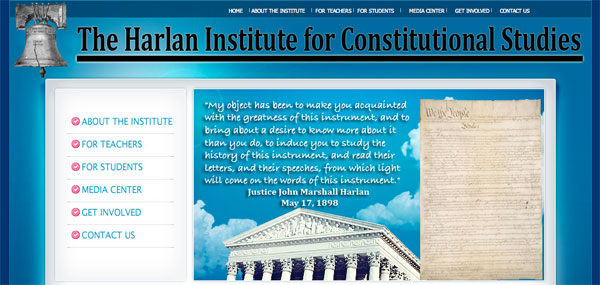I proudly introduce the Harlan Institute for Constitutional Studies at www.HarlanInstitute.org.
After launching FantasySCOTUS.net about a month ago, several Middle and High School teachers from across the Country contacted me, and told me how they are using this program in their government and political science classes. I soon realized the potential of harnessing the power of Web 2.0 to teach constitutional law. In the words of Justice Sanford in Gitlow, this insight created a spark, that led to a conflagration.
Following this idea, I partnered with Yaakov Roth to start the Harlan Institute for Constitutional Studies.
The mission of the Institute is to give effect to Justice Harlan’s prescient pedagogical call from over 100 years ago:
“Now it is essential to a clear understanding of our Constitution to know something of the circumstances under which those who framed it were placed. There are words in our constitution which are susceptible of different constructions, but their meaning are ascertained by knowing the circumstances which then existed and the laws and customs which went before. We ought to know what principles of government existed at the time and before that time, what right of life, liberty, and property existed and which went before the time when the colonies achieved their independence. Every lawyer knows the meaning of a rule of law is best ascertained by taking the history of the rule, back through the line of legislation and adjudications, up to the time when it was first enacted.”
Justice John Marshall Harlan
May 17, 1898
The Harlan Institute for Constitutional Studies was founded in honor of Justice John Marshall Harlan I. Justice Harlan was one of the greatest constitutional scholars of his era. At the turn of hte Century, Justice Harlan taught Constitutional Law at the George Washington (then Columbia) School of Law. One of his students transcribed the lecture notes verbatim. While taking a legal history class, I digitized all of these lecture notes at the Library of Congress. From these notes, I gained great insight into the mind of Justice Harlan, and how he explained the Constitution.
Rather than teaching the Constitution through cases, and occasionally mentioning the text of the Constitution, Justice Harlan taught the Constitution clause by clause, starting with the preamble, and concluding with the most recently added 15th Amendment. Most importantly, in his teachings, Justice Harlan sought to impart to his students the meaning of the Constitution by understanding that “which went before.”
The Institute seeks to continue Justice Harlan’s proud tradition of constitutional education.
The Institute aims to fuse cutting-edge technological initiatives with engaging educational programs designed by leading constitutional law scholars, historians, and Judges to show teachers and students the “greatness of this instrument.”
I encourage my readers to provide comments or thoughts about this new initiative. I have some ideas, but I am always open to suggestions.
